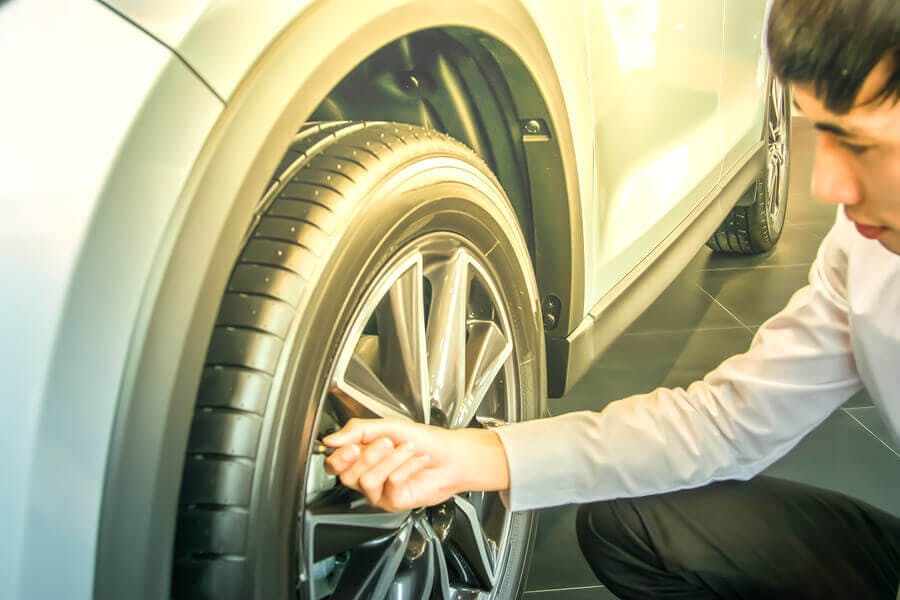A tyre health check could be one of the most important things you do to your car. Many drivers view their tyres as simply being round black things that periodically wear out or puncture.
But they are among the most crucial components on our vehicles.
The one thing an £8,000 city car has in common with an £800,000 hyper car is both use tyres.
And in both cases the only thing keeping those cars in contact with the road are the four little patches of rubber. So it pays to keep an eye on their condition.
Here are five ways to ensure your tyres stay in the best possible shape.
Page Contents
Tread Depth Test
All tyres have grooves in the rubber to help disperse water. As these wear down, the tyre’s ability to grip the road, particularly in the wet, decreases.
The legal minimum tread depth is 1.6mm but safety experts and tyre companies recommend that tyres are replaced when tread depth reaches 3mm. The reasoning is a car takes around two car lengths longer to stop on tyres with minimum tread as with 3mm tread.
There are various ways to check the tread depth. If you place your finger in the main tyre groove and run it along you should feel a small raised notch at various points. These notches are Tread Wear Indicators. They are 1.6mm high so when the main tread is flush with this the tyre should be replaced.
Alternatively, put a 20p piece in the groove between the tread blocks. If the rim round the outside of the coin disappears, the tyre has more than 1.6mm of tread.
As you should be checking for a depth of 3mm, the best way is to get a tyre tread depth gauge. These only cost a few pounds. Check the depth at various points across the width of the tyre: some can wear unevenly across the tyre.
Specialist tyre garages will check your tyre tread depth for free.
Pressure Check
Tyres that are under inflated by just 20 per cent lose around one fifth of their life span. This is because there is an increased amount of rubber in contact with the road and hence that rubber wears more.
Meanwhile over-inflated tyres wear unevenly and can result in longer stopping distances because there is less rubber than intended on the road.
You can find your car’s tyre pressures in your owner’s manual.
The Visual Inspection
For this test, you have one of the best tools with you at all times: your eyes. Look at the sides of your tyres periodically to check there aren’t any lumps or gashes. These can mean a structural defect possibly caused by a pothole and they’ll lead to premature failure of the tyre.
This failure is likely to be in the form of a blowout, where the tyre fails at speed.
Dust Caps Are Important
Valve or dust caps might be small and fiddly when you’re filling the tyres with air. But it’s very important to ensure they’re always fitted. The caps prevent small particles of grit, mud and water from sitting on the valve itself, causing it to wear corrode and leak. They also provide a secondary air pressure seal.
Without dust caps your tyres could lose pressure over time thanks to the tiny amount of air seeping out through the valve. Best to keep them on if you can.
How Old Are Your Tyres?
An overlooked aspect of tyre maintenance is age. If you cover 10-12,000 miles per year you will probably have to replace your tyres after around three years due to wear.
But those doing fewer miles might find their tyres’ age becoming a problem.
Tyres contain anti-oxidising chemicals which significantly slow down the rate of ageing. But this is only released when the tyre is in motion so an infrequently used tyre will gradually harden.
Check for the effects of ageing on a tyre by looking for small cracks in the sidewall. This is known as crazing and is a good indicator of the rubber hardening.
Also, check the tyre’s age. This is displayed through a four-digit manufacturing date stamped on the side. The first two digits are the week of manufacture (one to 52); the second two digits are the year. A tyre stamped with 3408 would have been built in Week 34, 2008.
You should consider replacing tyres that are older than five years.
Book online today!







